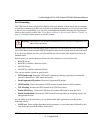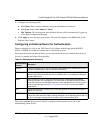
ProSafe Gigabit 8 Port VPN Firewall FVS318G Reference Manual
6-6 VPN Firewall and Network Management
v1.1, August 2010
• WAN Users. These settings determine which Internet locations are covered by the rule, based
on their IP address.
– Any. The rule applies to all Internet IP address.
– Single address. The rule applies to a single Internet IP address.
– Address range. The rule is applied to a range of Internet IP addresses.
• Destination Address. These settings determine the WAN destination IP address for this rule
which will be applicable to incoming traffic This rule will be applied only when the
destination IP address or IP address range of the incoming packet matches the IP address or IP
address range of the selected WAN interface.
• Services. You can specify the desired services or applications to be covered a rule. If the
desired service or application does not appear in the list, you must define it using the Services
screen (see “Adding Customized Services” on page 4-24).
• Schedule. If you have set firewall rules on one of the the LAN WAN Rules screen and the
DMZ WAN Rules screen, you can configure three different schedules (that is, schedule 1,
schedule 2, and schedule 3) for when a rule is to be applied. Once a schedule is configured, it
affects all rules that use this schedule. You specify the days of the week and time of day for
each schedule. (See “Setting a Schedule to Block or Allow Specific Traffic” on page 4-29 for
the procedure on how to use this feature.)
Port Triggering
Port triggering allows some applications to function correctly that would otherwise be partially
blocked by the VPN firewall. Using this feature requires that you know the port numbers used by
the Application.
Once configured, Port Triggering operates as follows:
• A PC makes an outgoing connection using a port number defined in the Port Triggering table.
• The VPN firewall records this connection, opens the additional incoming port or ports
associated with this entry in the Port Triggering table, and associates them with the PC.
• The remote system receives the PCs request and responds using the different port numbers that
you have now opened.
• The VPN firewall matches the response to the previous request and forwards the response to
the PC. Without port triggering, this response would be treated as a new connection request
rather than a response.
As such, it would be handled in accordance with the Port Forwarding rules.
– Only one PC can use a port triggering application at any time.


















